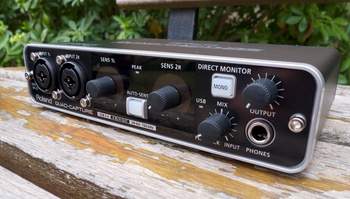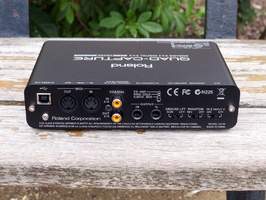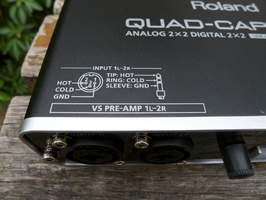Do you want a small sound card with a high quality sound, clever features, a good construction, and an affordable price? If you do, follow me to give Roland's Quad Capture a try. If you need even more, follow me too because Roland has something in store for you.
When it comes to audio interfaces, if you ask for renown manufacturers you’ll hear many brand names but probably not Roland.
The brand’s visibility is rather low in this market segment where it used to go under the name Edirol until a couple of years ago. Edirol audio interfaces were no “reference products” but offered a rather good value for money for beginners. Its audio quality didn’t quite meet professional standards. However, Roland has the knowhow for professional audio products: just consider the V-System digital live mixers sold under the brand name RSS (Roland System Solution).
So why not put RSS’ technology into a Roland sound card? That’s what Roland did with the Quad Capture… And it worked!
Description
The Quad Capture is a 4×4-channel audio interface with 2 analog plus 2 digital inputs and outputs.
Both analog inputs are on XLR/TRS combo connectors, while the line outputs are on balanced 1/4" jacks. All digital ins and outs are on coaxial connectors. You also get a 1/4" headphones out.
If we do the math, we have 4 input channels but how many output channels? 2 analog line-level output channels + 2 analog headphones channels + 2 digital output channels = 6 output channels, right?
Unfortunately not! Like the Duo and Tri interfaces, the headphones out doesn’t use dedicated channels, but rather the main output signal is just split inside the hardware to feed both outs. The monitoring quality doesn’t seem to be affected by this. However, in use it can become a bit annoying.
Add a pair of MIDI ins/outs and you get a full overview of the available connections. Surprisingly it lacks ADAT connectors, but considering the price…
All this is packed in a 19" half rack typical for 4×4 sound cards. The housing is made out of black metal except for the plastic front plate — and it looks nice. The rounded edges and the chrome binding surrounding the front panel give the unit a sleek but classy look. The big chrome BTR screws give it a professional touch. Considering its light weight (1.26 lbs, it seems that the metal sheet used for the housing is quite thin. But it is made out of aluminum instead of iron, which increases rigidity while decreasing weight. Thus, you can easily fit this sound card together with your laptop inside a (large) carry bag.
Moreover, the quality of the controls and buttons is pretty good. The same applies to the LED indicators on the front plate.
The rear switches are the only negative aspect. These small plastic switches feel quite cheap — the low price doesn’t come without compromises.
However, the quality of the switches is not the main problem, it is the functions they are assigned to.
The Quad looks nice and provides a quality feel that is very different from the abundant plastic products in this price range that try very hard to look pro. Pro musicians or sound engineers won’t be ashamed to take it out of their bags for a session.
Buttons and Functions
Monitoring, yes but…
Both inputs are located on the left side of the front panel. On the right side, you’ll find the headphones out and the monitoring controls. The latter include a pair of knobs: one for the main volume and one to balance the mix (the computer outs) and the inputs. Very useful. You’ll also find a Mono push-button that allows you to check out potential phase problems and to simplify your work when recording only mono sources. Nice!
Unfortunately, there are no independent controls to adjust the main and headphones level. To me, this is the sound card’s main drawback. If you have active speakers, it isn’t very practical to decrease the volume or mute them every time you want to monitor a signal with your headphones, or if you just want to switch between speakers and headphones while monitoring recording sessions. A real pity. If you are used to switching often between headphones and speakers, the latter must have an easily accessible volume control or a digital input (coaxial connectors).
Switches without indicators
The input settings are split between the front and rear panels, due to the switches mentioned above. The first switch enables the Hi-Z input (high-impedance input) to connect a guitar or bass directly to the interface. The second one activates the phantom power for condenser mics. Unfortunately, there is no indication on the front of whether these switches are engaged or not. This is especially annoying for the phantom power due to the risks of damaging a microphone when connecting or disconnecting it with the phantom power on. Another annoyance is the often dangerous incompatibility with ribbon microphones. Be careful!
The third switch is a very useful Ground Lift to avoid ground loops, especially on stage with a notebook. Nice!
Auto-Sens: The good genius
Let’s go back to the front panel with the gain settings (called SENS) in the center. Each knob is surrounded by a dim but distinguishable LED crown.
Between both controls, you’ll find the Auto-Sens switch, one of the highlights of the interface. Simply put, it is an auto-gain. For recording, just push this button and start playing: the gain will be set automatically for both channels. Push it a second time to store the settings…and you’re ready to record! This feature may look like a small detail but it saves lots of time and comes in very handy when you want to record yourself playing an instrument. Usually, you need a third hand to set the gain of the preamp. This function sets the ideal gain automatically with peaks at –12dB. Instead of going from your instrument to the gain control while keeping an eye on the level meters, you can now concentrate on your playing.
Thank you Roland!
And What About the Sound?
The good manufacturing quality and the great, musician-friendly Auto-Sens function of this interface wouldn’t be enough to generate much enthusiasm, especially considering the lack of status indicators and a dedicated monitoring stage.
But the sound is an important factor, and in this regard the Quad Capture excels. It is at the same or even higher level of an RME Multiface (and with a Roland Quad Mic preamp). It is true that the RME Quad Pre is a very linear preamp many people consider too cold, but keep in mind that it is twice as expensive as the Quad Capture!
This is well beyond the “quite good” results delivered by Edirol interfaces and certainly makes the Quad Capture apt for professional use.
Un document published by Roland explains the different technologies used to reach this high audio quality standard. Here’s a summary:
- In order to avoid interferences between circuits, the analog and digital stages have been built on different PCBs. Each of them has its own power supply, which allows the analog stage to be powered with a much higher voltage than the digital stage. Roland claims a 104 dB S/N ratio.
- The power supplies have been especially developed so that they are not affected by the typical power instabilities of a USB bus.
- A quartz-crystal clock ensures perfect sync and reduces jitter.
Note that you’ll find similar technologies in other audio interfaces, but Roland asserts that the power supply technology used in the Quad Capture is a proprietary development, just like the VS Streaming driver.
Anyway, the result is obvious: it sounds good! With my all-round notebook, which is not optimized for audio applications, I was able to work at very low latency times.

- entree Ligne-2200:33
- Basse-1600:39
- Basse COMP-1500:47
- SM58–2300:34
- comp SM58–1900:34
- SM58 prise Y-2600:34
- C414–1700:34
- comp C414–1800:35
- C414 prise Y-2700:33
- Gtr COMP directe-2000:16
- Gtr directe-2100:34
Additional Features
|
The Quad Capture uses a 40-bit DSP (Digital Signal Processor) providing each input with a compressor, a low-cut filter and a phase inverter.
I’m not really convinced about the compressor because I’m used to using dynamic processors later during the mix. The main use of a compressor on the source signal while recording is to avoid the AD converter from clipping. But since the compressor of the Quad Capture processes the digital signal, it doesn’t avoid clipping at the converter stage (luckily, the Auto-Sens function decreases dramatically the risks of clipping).
However, since this compressor works and sounds good, it can be useful for 2-track direct recording with a pair of mics or through a mixing console.
The low-cut filter and the phase switch are valuable tools for recording sessions, especially in combination with the microphone’s position.
Conclusion
If this audio interface had different audio channels for the main and headphones output, I would award it with the “Top Value” Award. In spite of the few cons detected, this audio interface is well built, offers MIDI and digital connections, low-latency operation and premium audio quality for only $270 —easily worth a “Value for Money” Award.
If your are seduced by the premium audio quality but need more connections, give the Octa Capture a chance — my first choice if I had to change my RME Multiface.






